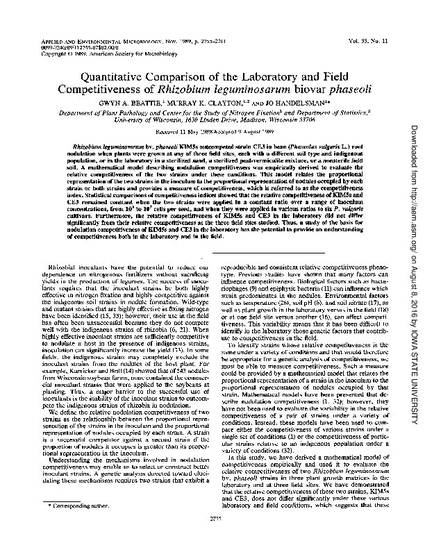
Article
Quantitative comparison of the laboratory and field competitiveness of Rhizobium leguminosarum biovar phaseoli
Applied and Environmental Microbiology
(1989)
Abstract
Rhizobium leguminosarum bv. phaseoli KIM5s outcompeted strain CE3 in bean (Phaseolus vulgaris L.) root nodulation when plants were grown at any of three field sites, each with a different soil type and indigenous population, or in the laboratory in a sterilized sand, a sterilized peat-vermiculite mixture, or a nonsterile field soil. A mathematical model describing nodulation competitiveness was empirically derived to evaluate the relative competitiveness of the two strains under these conditions. This model relates the proportional representation of the two strains in the inoculum to the proportional representation of nodules occupied by each strain or both strains and provides a measure of competitiveness, which is referred to as the competitiveness index. Statistical comparisons of competitiveness indices showed that the relative competitiveness of KIM5s and CE3 remained constant when the two strains were applied in a constant ratio over a range of inoculum concentrations, from 10(3) to 10(7) cells per seed, and when they were applied in various ratios to six P. vulgaris cultivars. Furthermore, the relative competitiveness of KIM5s and CE3 in the laboratory did not differ significantly from their relative competitiveness at the three field sites studied. Thus, a study of the basis for nodulation competitiveness of KIM5s and CE3 in the laboratory has the potential to provide an understanding of competitiveness both in the laboratory and in the field.
Disciplines
Publication Date
November, 1989
Publisher Statement
Copyright 1989, American Society for Microbiology
Citation Information
Gwyn A. Beattie, Murray K. Clayton and Jo Handelsman. "Quantitative comparison of the laboratory and field competitiveness of Rhizobium leguminosarum biovar phaseoli" Applied and Environmental Microbiology Vol. 55 Iss. 11 (1989) p. 2755 - 2761 Available at: http://works.bepress.com/gwyn-beattie/5/
